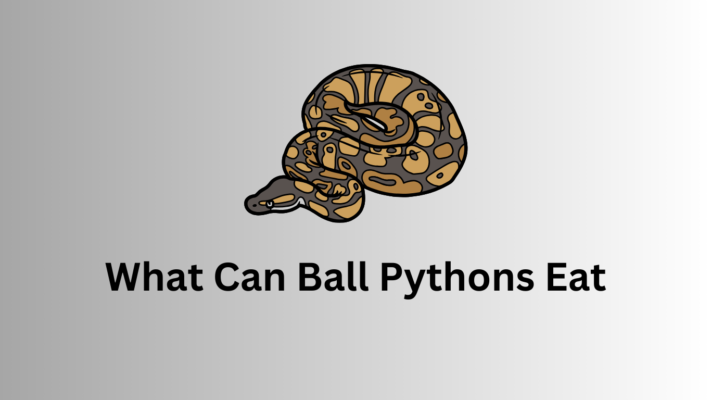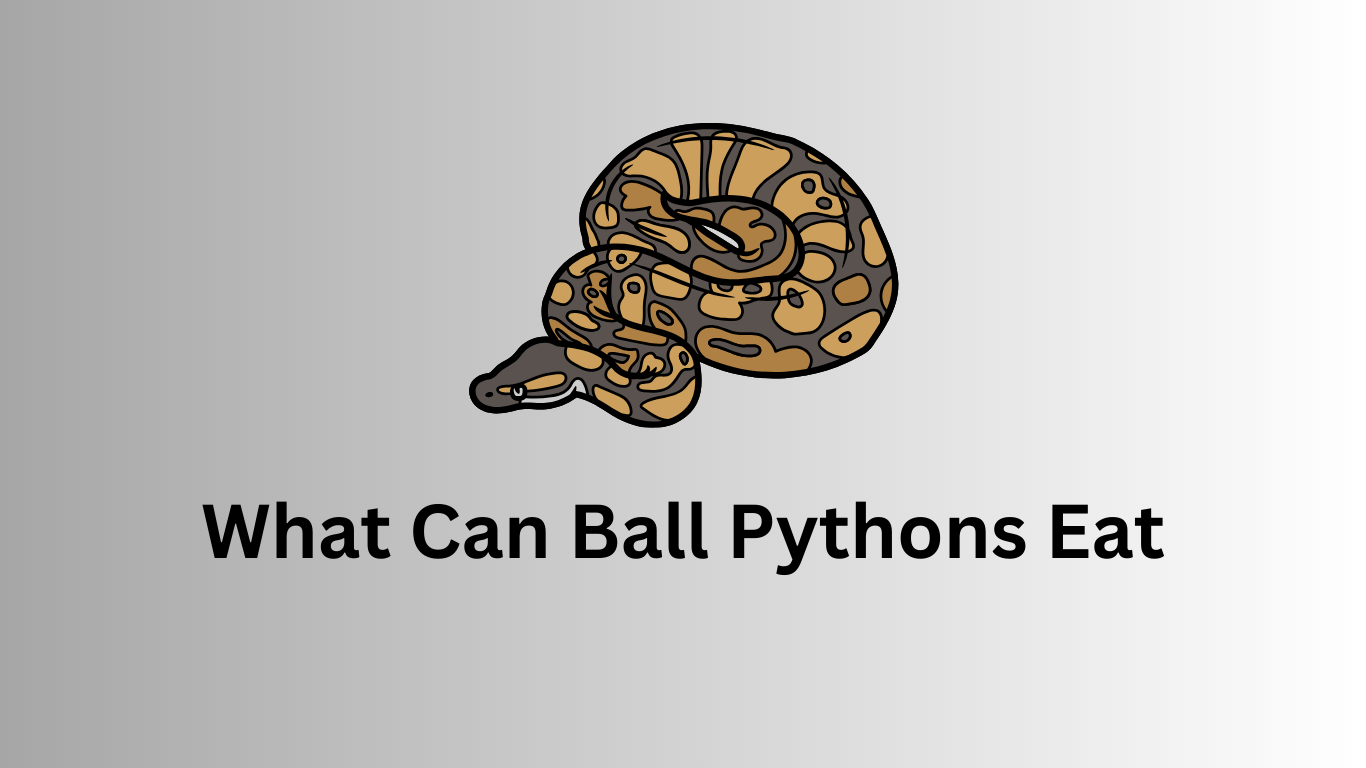Ball pythons, known for their captivating appearance and gentle disposition, make popular reptilian companions. However, to ensure the well-being of these fascinating snakes in captivity, it’s crucial to understand their dietary requirements. In this brief guide, we’ll explore what can ball pythons eat and cover everything you need to know about the ball python diet.
Importance of Understanding Their Dietary Needs
Understanding the dietary needs of ball pythons is crucial for several reasons:
Health and Well-being: Providing the correct diet ensures your pet ball python’s overall health and well-being. Proper nutrition is essential for growth, immune system function, and reproductive health.
Preventing Health Issues: An inappropriate diet can lead to various health issues, such as obesity, malnutrition, and metabolic problems. By knowing what ball pythons should eat, you can prevent these issues.
Behavioral Health: Properly fed ball pythons tend to be more active, exhibit natural behaviors, and are generally happier. Understanding their dietary needs can improve your pet’s quality of life.
Longevity: A well-balanced diet can significantly impact the lifespan of a ball python. When they receive the right nutrients, they are more likely to live longer and healthier lives.
Natural Ball Pythons Diet

Explanation of What Ball Pythons Eat in the Wild:
In their natural habitat in sub-Saharan Africa, ball pythons primarily feed on small mammals. This diet typically includes rodents such as mice, rats, and occasional birds. Their hunting strategy involves ambushing their prey, constricting it, and consuming it whole.
Understanding their wild diet is essential because it informs us about their evolutionary adaptations and nutritional requirements. Ball pythons have evolved to efficiently digest and derive nutrients from these prey items, which consist mainly of protein and some fat.
Discussion of Their Carnivorous Nature:
Ball pythons are obligate carnivores, meaning they exclusively eat animal matter. Their digestive systems are adapted for breaking down and absorbing nutrients from animal protein. Their carnivorous nature highlights the importance of providing them with a diet rich in animal-based protein sources.
Feeding them a diet that mimics their natural prey items is essential for their health. This usually involves offering them appropriately sized rodents in captivity, which provides the necessary protein and other nutrients. Understanding their carnivorous nature helps meet their dietary needs, promoting their overall health and vitality in captivity.
Overview of Keeping Ball Pythons as Pets
Ball pythons (Python regius) are among the most popular snake species kept as pets due to their manageable size, docile temperament, and striking appearance. They are native to sub-Saharan Africa but have become well-established in the pet trade. To provide the best care for captive ball pythons, it’s essential to understand their dietary needs.
When keeping ball pythons as pets, you are responsible for replicating their natural environment and dietary habits to the best of your ability. It includes providing a suitable enclosure with proper temperature and humidity levels and offering them a diet that meets their nutritional requirements.
Unlike wild ball pythons, captive snakes don’t have the opportunity to hunt for live prey, so it’s up to the owner to ensure they receive the appropriate diet.
Explanation of How Their Diet Differs from Their Wild Counterparts
Ball pythons’ diets in captivity often differ significantly from their wild counterparts. In the wild, they primarily consume live prey, such as small mammals like mice and rats and occasional birds. These prey items offer a natural source of protein and some fat, which is suitable for their carnivorous nature.
However, captive ball pythons are typically fed pre-killed or frozen-thawed prey items, which are more convenient and safer for both the snake and the owner. This shift from live to pre-killed or frozen-thawed prey is a notable difference between their wild and captive diets.
Additionally, the frequency and size of feedings may vary based on the snake’s age and specific needs, which further distinguishes captive diets from wild ones.
List of Common Prey Items for Ball Pythons
Mice: Mice are a staple prey item for ball pythons, especially for younger snakes or smaller ones. They come in various sizes, from pinkie mice (newborn mice) to adult mice. The size of the mouse should match the snake’s girth, ensuring it can be swallowed comfortably.
Rats: As ball pythons grow, they transition to larger prey items, such as rats. Like mice, rats come in various sizes, from rat pups to adult rats. These larger prey items provide the necessary nutrition for growing and adult ball pythons.
Birds (Optional): Some keepers offer birds, such as quail or small chickens, as an occasional prey item. It can provide variety in the diet but should not make up the majority of their meals. Ensure that the bird’s size is appropriate for the snake’s size.
Other Small Mammals (Optional): In some cases, other small mammals like gerbils, hamsters, or guinea pigs may be offered. However, these should be given sparingly, as they may not be as nutritionally balanced as mice or rats.
Age and Size Considerations for Choosing Prey
Choosing the right prey size is crucial for the health of your ball python. Here are some considerations based on age and size:
Hatchlings and Juveniles: Young ball pythons typically start with pinkie mice or rat pups, gradually moving up to larger sizes as they grow. A good rule of thumb is to select prey items that are no larger in diameter than the snake’s widest body section.
Sub-Adults and Adults: As ball pythons mature, they require larger prey items like adult mice or small rats. Again, choose prey that matches the snake’s girth. Avoid offering too small prey, as it won’t provide adequate nutrition.
Frequency of Feeding: Younger ball pythons may eat more frequently every 5-7 days, while adults may be fed every 10-14 days. Adjust the frequency based on the snake’s activity level, metabolism, and hunger or weight gain signs.
Variety: While mice and rats are the primary diet for ball pythons, offering variety occasionally can be beneficial. However, ensure that any additional prey items are nutritionally appropriate and properly sized.
Always monitor your ball python during feeding to ensure they are consuming the prey item without any difficulties. Prey items should be appropriately thawed (if frozen) and presented using tongs to avoid accidental bites during feeding. Providing a varied diet that matches your snake’s age and size will help maintain their health and ensure they receive the right balance of nutrients.
Common Feeding Issues and Solutions
Certainly, let’s explore common feeding issues that ball python owners may encounter and the corresponding solutions:
Recognizing Signs of Feeding Problems (e.g., Refusal to Eat):
Feeding issues can arise with ball pythons, and it’s crucial to recognize and address the signs promptly. Some common signs of feeding problems include:
Refusal to Eat: This is the most apparent sign of a feeding issue. If your ball python consistently refuses to eat, it may indicate stress, illness, or dietary dissatisfaction.
Striking and Immediately Releasing: Your snake may strike at prey but then release it without attempting to consume it. It can be a sign of stress, improper prey size, or issues with the prey itself.
Regurgitation: If your ball python regurgitates its meal shortly after eating, it could be due to overhandling, feeding too large of a prey item, or underlying health problems.
Weight Loss: Persistent refusal to eat can lead to weight loss in your snake, which is a clear sign of a feeding problem.
Solutions for Recognizing and Addressing Feeding Problems:
To address these issues:
Check Husbandry: Ensure the ball python enclosure’s temperature, humidity, and lighting are appropriate. Ball pythons are sensitive to environmental conditions, and improper husbandry can cause stress and feeding problems.
Prey Size: Ensure you’re offering appropriately sized prey items. The prey should be no larger than the snake’s girth, as swallowing prey that is too large can lead to regurgitation.
Minimize Handling: Ball pythons are generally solitary and prefer minimal handling, especially around feeding time. Avoid handling your snake for at least 24 hours before and after a meal.
Try Different Prey Types: If your snake consistently refuses one type of prey, consider trying an alternative, such as switching from mice to rats. Some individuals may have dietary preferences.
Addressing Potential Health Concerns Related to Diet:
Feeding issues can sometimes be indicative of underlying health problems. If you suspect a health concern related to your ball python’s diet, consult with a reptile veterinarian for a thorough examination. Common health-related feeding problems may include:
Respiratory Infections: Respiratory issues can affect a snake’s appetite. Symptoms include wheezing, open-mouth breathing, and nasal discharge.
Parasites: Internal parasites can disrupt digestion and lead to weight loss and decreased appetite.
Mouth or Dental Problems: Dental issues or mouth injuries can make it difficult for the snake to consume prey.
Metabolic Disorders: Metabolic issues like obesity or vitamin deficiencies can impact feeding behavior.
To address health concerns, seek professional veterinary care promptly. A veterinarian can diagnose and treat any underlying issues affecting your snake’s appetite.
Tips for Transitioning to Different Prey Items (if Necessary):
If you need to transition your ball python to a different prey item, follow these tips:
Gradual Transition: Gradually introduce the new prey item by offering it alongside the familiar prey. Over time, increase the proportion of the new prey.
Scenting: Rubbing the new prey with the scent of the familiar prey item can encourage acceptance.
Persistence: Be patient; some ball pythons may take time to adjust to a new prey type.
Variety: Offering a variety of prey items from the beginning can make transitions easier in the future.
Addressing feeding problems with patience, careful observation, and appropriate adjustments to diet and husbandry can help ensure your ball python maintains a healthy appetite and overall well-being.
Conclusion:
In conclusion, understanding what ball pythons can eat is essential for their health and happiness as captive reptiles. Their diet, primarily consisting of appropriately sized rodents, should be carefully managed to ensure they receive the right nutrients and maintain a healthy weight.
You can ensure that your ball python thrives in captivity by recognizing feeding issues, addressing health concerns, and providing a well-balanced diet. Remember, your role as a responsible keeper is vital in providing the best care for these fascinating snakes.
Related Articles:
Top 12 Best Snake Boots (2023 Review)
How Long Can a Ball Python Go Without Water? A Detailed Guide
Can a Ball Python Kill a Cat? Everything You Need To Know
Can Ball Pythons Live Together? A Detailed Guide
How Often Should I Feed My Ball Python? A Comprehensive Guide

